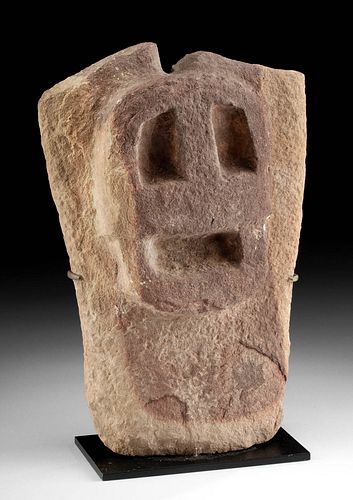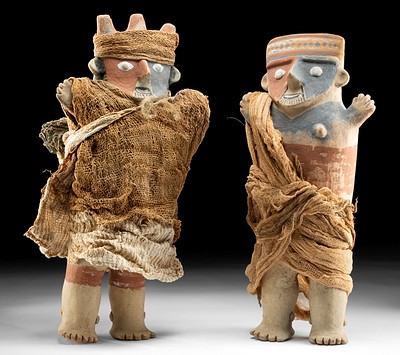Rare Bolivian Wankarani Sandstone Llama Head Relief
Lot 120
About Seller
Artemis Fine Arts
686 S Taylor Ave, Ste 106
Louisville, CO 80027
United States
Selling antiquities, ancient and ethnographic art online since 1993, Artemis Gallery specializes in Classical Antiquities (Egyptian, Greek, Roman, Near Eastern), Asian, Pre-Columbian, African / Tribal / Oceanographic art. Our extensive inventory includes pottery, stone, metal, wood, glass and textil...Read more
Estimate:
$7,000 - $10,500
Absentee vs Live bid
Two ways to bid:
- Leave a max absentee bid and the platform will bid on your behalf up to your maximum bid during the live auction.
- Bid live during the auction and your bids will be submitted real-time to the auctioneer.
Bid Increments
| Price | Bid Increment |
|---|---|
| $0 | $25 |
| $300 | $50 |
| $1,000 | $100 |
| $2,000 | $250 |
| $5,000 | $500 |
| $10,000 | $1,000 |
| $20,000 | $2,500 |
| $50,000 | $5,000 |
| $100,000 | $10,000 |
| $200,000 | $20,000 |
About Auction
By Artemis Fine Arts
May 19, 2022
Set Reminder
2022-05-19 10:00:00
2022-05-19 10:00:00
America/New_York
Bidsquare
Bidsquare : Fine Antiquities | Ethnographica | Fine Art
https://www.bidsquare.com/auctions/artemis-gallery/fine-antiquities-ethnographica-fine-art-9350
Featuring a very special collection of Fine Art from the Hollywood Hills, including Picasso & Rookwood ceramics! Also included are many fine examples of classical antiquities, ancient, and ethnographic art from cultures encompassing the globe. Artemis Fine Arts info@artemisgallery.com
Featuring a very special collection of Fine Art from the Hollywood Hills, including Picasso & Rookwood ceramics! Also included are many fine examples of classical antiquities, ancient, and ethnographic art from cultures encompassing the globe. Artemis Fine Arts info@artemisgallery.com
- Lot Description
Pre-Columbian, Western Bolivia, Central Andes, Altiplano / Collao / Andean Plateau, Cercado Province (Oruro), Wankarani Culture, Formative Period, ca. 1500 BCE to 400 CE. Wow! An incredibly rare sandstone relief of a llama head boasting natural hues of rose taupe and tan. The stylized animal presents minimalist features with a huge pair of recessed, rectangular eyes above a large mouth held open. The area above the head is bifurcated, suggesting that a pair of ears previously towered over the abstract visage. Stone llama heads, like this example, are the most famous components of Wankarani ritual life and have been found both on house floors and grouped together in caches outside Wankarani houses. Size: 9.9" W x 13.2" H (25.1 cm x 33.5 cm); 13.4" H (34 cm) on included custom stand.
Wankarani culture was a formative period culture of the altiplano highlands in Bolivia's Oruro Department that pre-dates the Tiahuanaco Empire. Existing from 1500 BCE to 400 CE, Wankarani is the earliest known sedentary culture in Bolivia. According to Timothy L. McAndrews, "The Formative Period (ca. 2000 B.C.–250 A.D.) in the Andean altiplano was characterized by several societal developments including the first sedentary lifeways, newly domesticated plants (potatoes and quinoa) and animals (llama and alpaca), the earliest pottery and metal (copper) technologies, and the emergence of more complex social organization (Burger 1992; Moseley 1992; Kolata 1993). The Wankarani is a Formative Period archaeological complex in the south-central Andean altiplano that exhibits these developments, representing the earliest known agricultural village-based settlement in the southern altiplano." ("Wankarani Settlement Systems in Evolutionary Perspective: A Study in Early Village-Based Society and Long-Term Cultural Evolution in the South-Central Andean Altiplano," University of Pittsburgh Memoirs in Latin American Archaeology no. 15 [2005]: pp. 1)
Cf. Museo Virtual Bolivia, 370 and 376, Margaret Young-Sanchez, "Introduction" in "Tiwanaku: Ancestors of the Inca," (Denver: Denver Art Museum, 2004): pp. 14, fig. 1.3; Timothy L. McAndrews, "Wankarani Settlement Systems in Evolutionary Perspective: A Study in Early Village-Based Society and Long-Term Cultural Evolution in the South-Central Andean Altiplano," University of Pittsburgh Memoirs in Latin American Archaeology no. 15 (2005): pp. 30, fig. 7; Marc Bermann and Jose Estevez Castillo, "Domestic Artifact Assemblages and Ritual Activities in the Bolivian Formative," Journal of Field Archaeology 22, no. 4 (1995): pp. 390, fig. 2; and John Wasson, "Preliminary report on the investigations of the 'Mounds' of Oruro, Bolivia," Khana, La Paz, Bolivia (March 1967): pp. 7.
Provenance: private Hawaii, USA collection, 1995 to 2010; ex-private Hans Juergen Westermann collection, Germany, collected from 1950 to 1960s
All items legal to buy/sell under U.S. Statute covering cultural patrimony Code 2600, CHAPTER 14, and are guaranteed to be as described or your money back.
A Certificate of Authenticity will accompany all winning bids.
PLEASE NOTE: Due to recent increases of shipments being seized by Australian & German customs (even for items with pre-UNESCO provenance), we will no longer ship most antiquities and ancient Chinese art to Australia & Germany. For categories of items that are acceptable to ship to Australia or Germany, please contact us directly or work with your local customs brokerage firm.
Display stands not described as included/custom in the item description are for photography purposes only and will not be included with the item upon shipping.
#170971Losses to ears. Expected chips, nicks, and abrasions throughout. Otherwise, excellent with light earthen deposits throughout.Condition
- Shipping Info
-
All shipping is handled in-house for your convenience. Your invoice from Artemis Gallery will include shipping calculation instructions. If in doubt, please inquire BEFORE bidding for estimated shipping costs for individual items.
-
- Buyer's Premium



 EUR
EUR CAD
CAD AUD
AUD GBP
GBP MXN
MXN HKD
HKD CNY
CNY MYR
MYR SEK
SEK SGD
SGD CHF
CHF THB
THB













